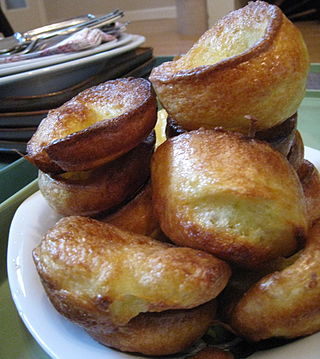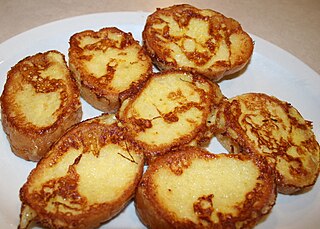
Dessert is a course that concludes a meal. The course consists of sweet foods, such as cake, biscuit, ice cream and possibly a beverage such as dessert wine and liqueur. Some cultures sweeten foods that are more commonly savory to create desserts. In some parts of the world there is no tradition of a dessert course to conclude a meal.

Yorkshire pudding is a baked pudding made from a batter of eggs, flour, and milk or water. A common British side dish, it is a versatile food that can be served in numerous ways depending on its ingredients, size, and the accompanying components of the meal. As a first course, it can be served with onion gravy. For a main course, it may be served with meat and gravy, and is part of the traditional Sunday roast, but can also be filled with foods such as bangers and mash to make a meal. Sausages can be added to make toad in the hole. In some parts of England, the Yorkshire pudding can be eaten as a dessert, with a sweet sauce called raspberry vinegar. The 18th-century cookery writer Hannah Glasse was the first to use the term "Yorkshire pudding" in print.

Cooking bananas are a group of starchy banana cultivars in the genus Musa whose fruits are generally used in cooking. They are not eaten raw and generally starchy. Many cooking bananas are referred to as plantains or 'green bananas'. In botanical usage, the term "plantain" is used only for true plantains, while other starchy cultivars used for cooking are called "cooking bananas". True plantains are cooking cultivars belonging to the AAB group, while cooking bananas are any cooking cultivar belonging to the AAB, AAA, ABB, or BBB groups. The currently accepted scientific name for all such cultivars in these groups is Musa × paradisiaca. Fe'i bananas from the Pacific Islands are often eaten roasted or boiled, and are thus informally referred to as "mountain plantains", but they do not belong to any of the species from which all modern banana cultivars are descended.

French toast is a dish of sliced bread soaked in beaten eggs and often milk or cream, then pan-fried. Alternative names and variants include eggy bread, Bombay toast, gypsy toast, and poor knights (of Windsor).

Glutinous rice is a type of rice grown mainly in Southeast and East Asia, and the northeastern regions of South Asia, which has opaque grains, very low amylose content, and is especially sticky when cooked. It is widely consumed across Asia.

A pancake is a flat cake, often thin and round, prepared from a starch-based batter that may contain eggs, milk and butter, and then cooked on a hot surface such as a griddle or frying pan. It is a type of batter bread. Archaeological evidence suggests that pancakes were probably eaten in prehistoric societies.

Curd is obtained by coagulating milk in a sequential process called curdling. It can be a final dairy product or the first stage in cheesemaking. The coagulation can be caused by adding rennet, a culture, or any edible acidic substance such as lemon juice or vinegar, and then allowing it to coagulate. The increased acidity causes the milk proteins (casein) to tangle into solid masses, or curds. Milk that has been left to sour will also naturally produce curds, and sour milk cheeses are produced this way.

Gulab jamun is a sweet confectionary or dessert, originating in the Indian subcontinent and a type of mithai popular in India, Pakistan, Nepal, the Maldives and Bangladesh, as well as Myanmar. It is also common in nations with substantial populations of people with South Asian heritage, such as Mauritius, Fiji, Gulf states, the Malay Peninsula, Great Britain, South Africa, and the Caribbean countries of Jamaica, Trinidad and Tobago, Guyana, and Suriname.

Filipino cuisine is composed of the cuisines of more than a hundred distinct ethnolinguistic groups found throughout the Philippine archipelago. A majority of mainstream Filipino dishes that compose Filipino cuisine are from the food traditions of various ethnolinguistic groups and tribes of the archipelago, including the Ilocano, Pangasinan, Kapampangan, Tagalog, Bicolano, Visayan, Chavacano, and Maranao ethnolinguistic groups. The dishes associated with these groups evolved over the centuries from a largely indigenous base shared with maritime Southeast Asia with varied influences from Chinese, Spanish, and American cuisines, in line with the major waves of influence that had enriched the cultures of the archipelago, and adapted using indigenous ingredients to meet local preferences.

A rice cake may be any kind of food item made from rice that has been shaped, condensed, or otherwise combined into a single object. A wide variety of rice cakes exist in many different cultures in which rice is eaten. Common variations include cakes made with rice flour, those made from ground rice, and those made from whole grains of rice compressed together or combined with some other binding substance.

Dominican cuisine is made up of Spanish, indigenous Taíno, Middle Eastern, African, Cuban, Puerto Rican and Haitian influences. The most recent influences in Dominican cuisine are from the British West Indies and China.

Sheer khurma or sheer khorma is a festival vermicelli pudding prepared by Muslims on Eid ul-Fitr and Eid al-Adha in India, Pakistan, Afghanistan, and parts of Central Asia. It is equivalent to shemai, a Bangladeshi dessert. It is a traditional Muslim festive breakfast, and a dessert for celebrations. This dish is made from various dry fruits, vermicelli, condensed milk, sugar etc. Depending on the region, cardamom, pistachios, almonds, cloves, saffron, raisins, and rose water are also added.

Latík refers to two different coconut-based ingredients in Filipino cuisine. In the Visayan region it refers to a syrupy caramelized coconut cream used as a dessert sauce. In the northern Philippines, it refers to solid byproducts of coconut oil production, used as garnishing for a variety of desserts.

Crème brûlée or crème brulée, also known as burnt cream or Trinity cream, and virtually identical to crema catalana, is a dessert consisting of a rich custard base topped with a layer of hardened caramelized sugar. It is normally served slightly chilled; the heat from the caramelizing process tends to warm the top of the custard, while leaving the center cool. The custard base is generally flavored with vanilla in French cuisine, but can have other flavorings. It is sometimes garnished with fruit.

Stir-fried ice cream, also known as rolled ice cream, is a sweetened frozen dessert. It is made using milk, cream and sugars as well as other added ingredients to improve the flavor. The liquid mixture is stirred constantly to incorporate air spaces on an ice pan and simultaneously cooled to −30 °C (−22 °F) in a motion somewhat resembling stir frying. The completed rolling process results in rolls of smooth, semisolid ice cream or gelato. The rolls are placed in a vertical position in an ice cream cup, topped off with various toppings and decorations, and eaten with a spoon.

Betawi cuisine is rich, diverse and eclectic, in part because the Betawi people that create them were composed from numbers of regional immigrants that came from various places in the Indonesian archipelago, as well as Chinese, Indian, Arab, and European traders, visitors and immigrants that were attracted to the port city of Batavia since centuries ago.

Maithil cuisine, also known as Mithila cuisine, is a part of Indian and Nepalese cuisine. It is the traditional cooking style of Maithils residing in the Mithila region of the subcontinent.

















